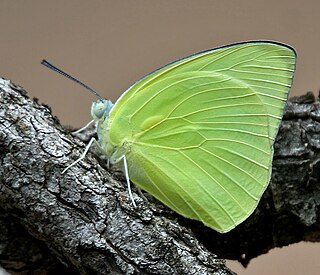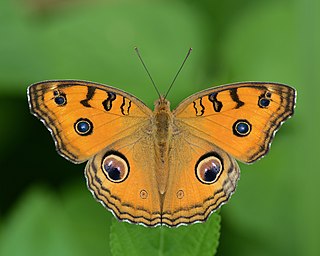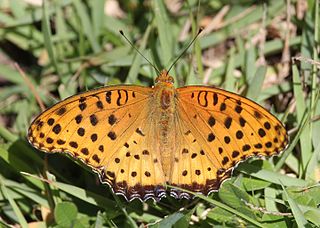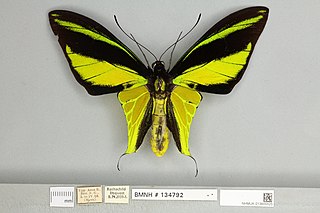
Graphium antiphates, The Five-bar swordtail or the green black-striped giant jay is a species of papilionid butterfly found in South and Southeast Asia. The species was first described by Pieter Cramer in 1775.

Insect wings are adult outgrowths of the insect exoskeleton that enable insects to fly. They are found on the second and third thoracic segments, and the two pairs are often referred to as the forewings and hindwings, respectively, though a few insects lack hindwings, even rudiments. The wings are strengthened by a number of longitudinal veins, which often have cross-connections that form closed "cells" in the membrane. The patterns resulting from the fusion and cross-connection of the wing veins are often diagnostic for different evolutionary lineages and can be used for identification to the family or even genus level in many orders of insects.

Ixias pyrene, the yellow orange tip, is a small butterfly of the family Pieridae, that is, the yellows and whites, which is found in Sri Lanka, India and southeast Asia.

Catopsilia pomona, the common emigrant or lemon emigrant, is a medium-sized pierid butterfly found in Asia and parts of Australia. The species gets its name from its habit of migration. Some early authors considered them as two distinct species Catopsilia crocale and Catopsilia pomona.

Catopsilia pyranthe, the mottled emigrant, is a medium-sized butterfly of the family Pieridae found in south Asia, southeast Asia, and parts of Australia.

This glossary of entomology describes terms used in the formal study of insect species by entomologists.

Miletus symethus, the great brownie, is a small butterfly found in India that belongs to the lycaenids or blues family. The species was first described by Pieter Cramer in 1777.

Junonia almana, the peacock pansy, is a species of nymphalid butterfly found in Cambodia and South Asia. It exists in two distinct adult forms, which differ chiefly in the patterns on the underside of the wings; the dry-season form has few markings, while the wet-season form has additional eyespots and lines. It is listed as Least Concern in the IUCN Red List.

The Indian fritillary is a species of butterfly of the nymphalid or brush-footed family. It is usually found from south and southeast Asia to Australia.

Ornithoptera meridionalis, the southern tailed birdwing, is the smallest species of the genus Ornithoptera. It is known from a handful of localities in southeast Papua, New Guinea and several localities along the south coast of Irian Jaya.

Zygoballus sexpunctatus is a species of jumping spider which occurs in the southeastern United States where it can be found in a variety of grassy habitats. Adult spiders measure between 3 and 4.5 mm in length. The cephalothorax and abdomen are bronze to black in color, with reddish brown or yellowish legs. The male has distinctive enlarged chelicerae and front femora. Like many jumping spiders, Z. sexpunctatus males exhibit ritualized courtship and agonistic behavior.

Aglais caschmirensis, the Indian tortoiseshell, is a species of nymphalid butterfly found in the northern regions of the Indian subcontinent, primarily in the Himalayas.

Zygoballus nervosus is a species of jumping spider which occurs in the eastern United States and Canada.

Rugathodes sexpunctatus is a minute species of spider in the family Theridiidae, the cobweb or tangle-web spiders. This family includes the medically important genus Latrodectus—the widow spiders. The species in the genus Rugathodes are too small to be dangerous to humans. Very little is known about most species in this genus.

Papilio forbesi is a butterfly of the family Papilionidae. It is endemic to Sumatra.

Colias fieldii, the dark clouded yellow, is a butterfly in the family Pieridae. It is found in southern Iran, India, southern China, Indochina, and Ussuri.
Chrysotoxum flavifrons, the Blackshield Meadow Fly, is a species of North American hoverfly. They are wasp mimics.

Riodina lysippus is a species of Neotropical metalmark butterfly. It is the type species of its genus and of the entire family Riodinidae. It is found throughout northern parts of South America and the Caribbean.

Probergrothius is an Old World genus of true bugs in the family Pyrrhocoridae. The genus was previously referred to as Odontopus, but that name was already in use for a genus of weevils, and was therefore replaced by Probergrothius in 1904. Members of this genus are reported to feed mainly on members of the plant order Malvales, including Sterculia, baobab (Adansonia), and kapok, but will feed on others as well. The welwitschia bug, Probergrothius angolensis, feeds on Welwitschia seeds, which is a gymnosperm, unlike the Malvales, which are angiosperms.

Probergrothius angolensis, sometimes known as the Welwitschia bug, is a species of true bug found in the Namib desert and nearby regions.

















